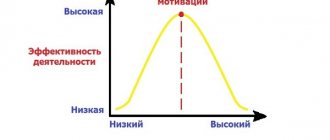- Tweet
- Share 0
- VKontakte
- 0
- Login to have your vote counted
We have already told you how to plan and implement goals using proven tools: mind maps, the Eisenhower matrix, etc. You will significantly increase the effectiveness of your actions if you change your attitude towards life - look at everything through the prism of Pareto’s law.
What is Pareto's law?
The essence of this law:
20% of effort produces 80% of the result, and the remaining 80% of effort produces only 20% of the result.
It is also called the Pareto principle, the law of least effort, or the 20/80 rule. It is deciphered as follows: a smaller part of the actions (20%) is responsible for most of the achievements (80%), and all other efforts (80%) will bring insignificant results (20%).
The main idea is to soberly assess the effectiveness of activities and focus on the most important things that will bring maximum results. What knowledge and skillful use of the law will give you:
- You will choose the most effective resources to achieve your goal.
- You will significantly reduce costs.
It turns out that this is the principle of “optimality”. You need to choose the right minimum of the most important actions, and it will be easier for you to achieve your goals. As a result, you will not get exactly what you expected, but you will avoid unnecessary costs for 100% effect.
1949: Zipf's principle of least effort
One of these pioneers was Harvard Philology Professor George C. Zipf.
In 1949, he discovered the principle of least effort, which was essentially the Pareto Principle rediscovered and thoroughly substantiated. Zipf's principle stated that resources (people, goods, time, knowledge or any other source of output) self-organize to minimize the work expended, and thus approximately 20-30% of any resource produces 70-80% of the activities involved. with this resource. To demonstrate the constant recurrence of this pattern of imbalance, Professor Zipf looked at population statistics, the field of philology, and industrial dynamics. For example, he analyzed the statistics of all marriages concluded in 1931 in 20 blocks of the city of Philadelphia, and showed that 70% of marriages were concluded between people living from each other at a distance of no more than 30% of the length of this territory.
Zipf gave a scientific explanation for the fact that there is never order on the desktop, and justified the disorder with another law: things are as close to us as often as we use them. Well, smarter secretaries realized a long time ago that they don’t need to file frequently used papers!
Brief historical background: why 80/20
So, where did this Pareto principle come from, which, by the way, was not derived by Pareto at all.
Vilfredo Pareto is an outstanding economist and sociologist, but nevertheless, during his lifetime he did not propose any principles. He worked with questions of equilibrium in social systems.
Pareto studied how income was distributed in Italy. He noticed that only 20% of families own 80% of the finances in the country, and the remaining 80% get only 20% of the money. The scientist studied the history of the economies of other countries and came to the conclusion: the imbalance of income distribution is approximately the same everywhere and at all times.
Wilfredo proposed several theories that explain his discovery - economists from different countries recognized its importance, applauded and forgot, that is, the idea never gained popularity and application. At least until World War II.
And it was a completely different person who discovered the universality of this principle and gave it the name “Pareto” - Joseph Juran, a specialist in the field of quality. He was impressed by Pareto's book and became very interested in the 80/20 ratio. His research showed: up to 80% of the maximum possible achievable indicators are the result of about 20% of labor costs. After this, the Pareto law began to be used not only in economics, but also in many other areas.
Winner takes all
The far-reaching implications of the Pareto principle have been revealed to the general public a century after Pareto discovered it, in recent discussions about the astronomical and ever-increasing incomes of superstars and the wealthiest few in certain professions. Director Steven Spielberg earned $165 million in 1994. Joseph Jamiel, the highest paid lawyer, received 90 million. It’s just that directors and lawyers who are competent in their field, of course, earn negligibly little in comparison with these amounts.
In the 20th century, massive attempts were made to equalize incomes, but inequality, eradicated in one area, suddenly appears in another. In the United States, real incomes of non-managerial workers fell by 14% between 1973 and 1995. In the 1980s, all income growth went to the top 20% of people, and a mind-boggling 64% of all growth went to the top 1%. The lion's share of all private equity holdings in the United States is in the hands of a very few owners: 5% of American households hold approximately 75% of all assets. If we look at the role of the dollar in the modern world, we see the same picture: almost 50% of world trade is settled in US dollars, which far exceeds the 13% US share of world exports. The world's foreign exchange reserves are 64% dollars, although the US share of gross domestic product in global gross product is only slightly more than 20%. The 80/20 principle will work always and everywhere unless you make a conscious, persistent and massive effort to overcome it.
Advertising
Where it manifests itself in life: examples
Proponents of the principle say that it appears everywhere, if you just look closely:
In law. In 80% of all accidents, only 20% of drivers are at fault.
In economics. 20% of the working population provides for 80% of pensioners. The rest do not work, do not pay taxes, etc.
In science. 20% of scientists make 80% of discoveries and create 80% of inventions.
In trade. 80% of a company's profit comes from 20% of its customers. 80% of sales come from 20% of products.
In productivity. 80% of the work takes 20% of the time. 80% of the profits come from only 20% of the employees.
At home. 80% of the time a person wears 20% of the clothes that he has in his wardrobe.
In a hobby. Only 20% of books provide 80% of the useful knowledge and skills that will be useful to us in life.
In the study of foreign languages. For everyday communication, it is enough to learn 20% of words.
In losing weight. To lose excess weight, it is enough to eat 20% less than usual - a calorie deficit brings 80% of the result.
In real life, the numbers are not so accurate, but in general the pattern of uneven distribution of effort can be seen everywhere.
Three Keys to Living Without Limits
The three most important keys are clarity, competence and focus.
Clarity of desires
This means that you know well who you are, what you want and where you are going. You write down your goals and make plans to achieve them. You prioritize very carefully and do something every day to move towards your goals. And the more you achieve, the more confidence and belief you have that there are no limits to what you can achieve.
Being clear about your desires and your future helps you focus on your daily activities. This is one of the most important habits of successful people.
This is why goal-oriented people tend to be more successful in life than those who don't set goals regularly. They are also more likely to be mindful of their time management and tend to be interested in productivity techniques such as the Pareto principle.
Principles of law
- To achieve most of your plans, it is enough to put in a small amount of effort.
- Much of what we usually do to implement plans is ineffective or useless.
- What seems logical at first glance is not always correct.
- Most failures depend on a small percentage of unfavorable factors.
- Striving for a 100% result is irrational: it will require 100% effort. While for 80% of the result, 20% of actions are enough.
To increase profits
Let's say you have a store. Now you know that only 20 percent of the product makes up the entire profit. It's not hard to calculate. what goods these are (mostly the cash register is made up of cigarettes, bread, alcohol, sausages and dairy products - what everyone needs) and place the main bet on them. If there is sausage, then there are 20 types, if there is kefir, then there are ten different manufacturers to satisfy the tastes of even the most capricious buyer. Of course, other goods should be in the store - but in several positions each, so as not to run out of money. It's the same with clients. Here you have your own business - for example, creating landing pages and websites. You have regular clients on whom all your work rests - for example, a marketing agency that often places orders and leaves good sums. Guess how many such clients there are? That's right, plus or minus 20 percent, they need to be licked from head to toe. The rest, of course, also need to be made happy in all available ways, but the main attention should still be paid to the most solvent.
Reliability and effectiveness of Pareto's law
Let us repeat, the 80/20 numbers are not always accurate and work, but the very idea of the law really helps to optimize any activity. By choosing a certain minimum of effort, you will achieve 80% of your goals. Only here there is an important point - a minimum of true effort. Which ones exactly? It depends on the situation, location and other details.
The reason that explains the 80/20 ratio is that most of the action is wasted. Let's take the same job: many employees spend not even 40% of their time on it. If you calculate in general for a month or a year, about 20% of the total time spent in the office is spent directly on work. The rest is social networks, games, office intrigues, etc.
To make the law as useful as possible, understand:
- It is not the ratio that needs to be taken into account, but the very idea of the principle that initially there is an imbalance in everything in the world.
- It is unrealistic to organize everything in such a way as to eliminate absolutely all ineffective actions.
- You can figure out what provides the main exhaust and prioritize what's most important.
Main conclusions from the “imbalance principle”
Knowing the 20/80 pattern provides great opportunities for those who are tired of knocking on a closed door. The main thing is to draw the right conclusions from this statement. Of course, you can practice building logical chains on your own. But just in case, I’ll tell you the main conclusions (this will be exactly in the spirit of our topic):
- most of our daily efforts have little effect and simply take away our precious time;
- important factors that truly determine success are single, trivial ones are numerous;
- our vision of reality is often far from objective, therefore it is important to take into account the nuances;
- You need to be able to evaluate the effectiveness of an idea at the very beginning, and if it is insufficient, think through optimization options;
- no matter what efforts we make, they will be largely ineffective.
By considering all your affairs and concerns in this context, you will learn to manage your time and energy, money and emotions as efficiently as possible. If, of course, you are focused on success, and not just going with the flow.
How to use 80/20 to be more effective?
Fix and control what you want, how and when it needs to be realized. You can use SmartProgress to set goals, plan and control tasks - this is a service in which thousands of people talk about their dreams, how they make them come true, follow the achievements of other users and support each other.
SmartProgress has tips that help you formulate your goal correctly. You can break a task into small steps, specify completion dates, and receive reminders.
In time management
Do you want to know a miracle cure that will help you do everything, everywhere and always? It does not exist. There are no Caesars among us - it is unrealistic to grab a hundred things and cope with everything. But we can choose the most important thing and competently plan our day, week, month, life.
We spend 20% of our time on useful activities, and 80% on social networks, cats and other pleasant, but of little use, things.
It is difficult for an ordinary person to plan a day: he is scattered about a bunch of small things, he procrastinates. As a result, I felt like I had been working all day and didn’t get much done. What to do:
- Focus on the 20% of things that are most important.
- Start with the most difficult.
- Deal with other tasks using the residual principle.
- Do your main work at the time when you are most effective.
Example:
Problem. Katya is an owl. He struggles in vain with himself to learn to get up at 6 and do everything. Even after waking up at 9 am and seeing a huge to-do list, he wants to fall asleep. And don't wake up.
Solution. According to Pareto's law, Katya has revised her schedule - she schedules important meetings for lunch, plans things later in the evening, and reschedules minor tasks.
Result. Katya stopped feeling exhausted by the beginning of the day, she began to really work, and not create an appearance. Now she enjoys a simple but productive day and gets more rest because she saves time.
For self-development
Being a good specialist in several areas at once and understanding a little of everything is a dubious goal. Few people can actually achieve this, and besides, in life, only 20% of skills bring worthwhile results.
To be successful, it is enough to make every effort to develop in one direction - the one that is most suitable for you.
Spraying yourself on mastering skills that are given through “I don’t want to” because it’s fashionable or just “to have it” is generally a bad idea that wastes time and effort.
Example:
Problem. Dima never liked English - at school he was at a level slightly lower than Landan from the Capital of Great Britain. On Google, he came across an article that knowing English will double your chances of earning a high income. And also Chinese, computer skills, psychology... He attended every training in the city and watched recordings of business conferences online, but did not receive moral and financial satisfaction.
Solution. Dima decided to try the 80/20 rule: he focused on a small part of his skills - his strengths. He began to work more on communication and got a job as a consultant in a prestigious company.
Result. Dima enjoys his work and does not get distracted by thousands of tasks that tire but do not bring any benefit. Little by little order is being built in my head. There is more time for family and hobbies.
To achieve your goals
We are accustomed to thinking that all factors in our lives have approximately the same influence. We will give our best 50%, we will implement our plans 50%. But this is not true: our actions have an unequal impact on our lives and the final result. What to do about it:
- Concentrate on those actions that bring results.
- If something can be removed from the task list almost painlessly, do it.
Once again we are convinced that in fact everything simple is brilliant. But for humanity to truly understand and learn to use this law to optimize life, it took many inspiring examples and an elegant 80/20 ratio.
Example:
Problem. Veronica loves to make big lists of goals, carefully plan and bring everything to perfection. Typical perfectionist. Because of this, she works on each task for a long time, and as a result, she gets what she wants at the wrong time or does not experience proper satisfaction at all.
Solution. Pareto's law revealed to Veronica a seemingly banal but effective thing: you need to do what leads to success - only those same 20% of efforts. This is what helps you achieve your goals!
Result. The quantity, but not the quality, of goals achieved has increased. She no longer gives 100, but she manages her life better and makes her dreams come true faster. Does not waste time on things that require a lot of effort but provide only minor satisfaction. I learned to mercilessly remove useless activities from my to-do list.
Define the "central node"
When you make a list of activities and see how much time you spend on each, you will understand whether you are spending your hours correctly. Suppose there is a task to earn more this month than last month. To achieve it, you need to “outline” your working day. Look at how much time you devote to communicating with clients, how much to gathering information for professional development, and how much to browsing social networks and meetings with colleagues. Already at this stage, you can identify the “important” and, for the sake of the goal, abandon Instagram and Facebook.
Take a deeper look at each of these actions. If you see that most of the time spent on contact with partners gives only 20% of the professional result, then you need to reduce your participation in such negotiations. Shift the focus of communication towards only work topics and those employees who will help you achieve more.
The same goes for clients. According to the rule, 2 out of 10 customers will give 80% of the result. Determine which of them you can earn more with and focus on communicating with them.
As time passes, priorities shift. Therefore, periodically review the list and identify new “central nodes”.
Memo
To achieve success using Pareto's Law:
- Make efforts in those areas of life where your abilities will provide the best results at minimal cost.
- Identify resources that will help you move toward your goal most effectively. Strengthen and develop them.
- Don't waste time on ineffective resources.
- Of all the paths that lead to your goal, choose the shortest. Let the result be not 100%, but 80%, but you won’t have to wait long, and there will be time to conquer new heights.
Do you use Pareto's law in life? What principles do you follow to be more effective?
- Tweet
- Share 0
- VKontakte
- 0
- Login to have your vote counted
Set the execution order
Once you have identified the important actions, you need to put them in the correct sequence. Among them there are those that require more resources than others. Working with a contractor can be more important than interaction with a client, which, in turn, can be more important than long meetings or training.
One more tip
The Pareto principle speaks of 20% of resources that provide the main 80% of the result. But the proportion is not always like this. It varies and can be 10/90 or 24/76. The point is to become more productive and increase the first number. But don't try to turn it into 100%. Don't forget about showering, eating well, and hanging out with friends. Without completing the secondary part, the main goal loses relevance.
Plan a strategy for the “unimportant” things. If that doesn’t work, “insert” them in between “important” ones. This will distribute mental and physical stress, help you relax and get distracted. As a result, you will cope with secondary goals and maintain efficiency for priorities.
Read: How to stop being distracted or 10 ways to calm your mind











